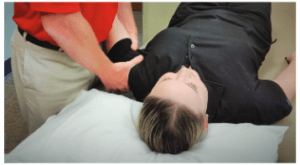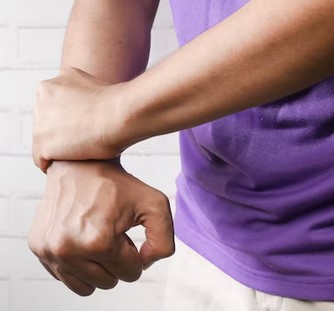Acromicioclavicular (AC) Joint (Shoulder) Injuries
Our acromioclavicular joint (also called “AC” joints) refers to the joint at the top of our shoulder, where the acromion (shoulder blade) attaches to the clavicle (the collarbone). That’s why it’s called acromioclavicular joint.
These kind of painful shoulder injuries typically happens due to sudden traumatic events such as sports or falling directly on the outside part of the shoulder. In some cases, it can also be caused by wear and tear from repeated use over time too.
Younger active and athlethic individual are more likely to engage in
- contact sports
- higher risk
- collision activities
think of sports / activities such as soccer, rugby, biking, hockey, boxing, skiing etc – that’s why these kind of traumatic shoulder acromioclavicular joint injuries happen in younger crowds below 40 years of age. It happens to more males than females at a rate of 5:1 (ie for every 6 AC joint injuries, 5 will be guys and 1 will be a lady patient.
The upside is that shoulder AC joint injuries can be identified and effectively treated by an experienced physiotherapists, and even help patients avoid shoulder surgery.
Contents
First: what are acromicioclavicular (AC) Joint Injuries?

There four (4) ligaments that holds the two (2) bones of the AC joint together – that’s why when there’s an AC joint injury, it’s at least one or more of these four ligaments that gets stressed and strained. In some cases, they may even get torn partially or fully (rupture).
So the two types of shoulder AC joint injuries are:
Traumatic AC joint injury
A traumatic AC joint injury happens due to higher impact events and accidents, causing a disruption or damage to the ligaments in the joint (different from shoulder dislocation which basically means the ball-socket shoulder joint). In this case, it’s purely one or more of the four AC joint ligaments that are damaged or torn.
Traumatic AC joint injuries are most common in individuals who sustain a fall and land on the outside of the shoulder or onto a hand eg
- a rugby or soccer player who was tackled
- a cyclist who crashed their bicycle (applies to a motorbike user as well)
- a person who fell off a ladder or from a height
Traumatic shoulder acromioclavicular joint injuries are graded from mild to severe based on the amount of separation of the AC joint. Treatment of mild cases likely will be provided and solved with shoulder physiotherapy; more severe AC injuries may require shoulder surgery followed by post-surgery physiotherapy.
Overuse / repetitive injuries
For the overused AC joint injury which occurs over time the AC joint is stressed and strained on a repetitive basis. After some time (some people’s joint wear out faster, some slower), this causes the cartilage to be worn out, leading to overuse injury. Of course it’s not like it happens suddenly, it’s gradual:
- first no issues in the shoulder
- then start to experience some soreness or ache in shoulder that will go away with rest
- the ache starts to linger longer, and takes longer to feel better
- pain and ache develops and doesnt improve with rest
- sharp pain
Significant wearing out of the AC joint cartilage is known as arthritis.
Overuse AC joint injury is most common in individuals who perform tasks that involves load / weight with the arms stretched over the head. These are typically seens in
- weight lifting
- care givers of young and old who has to lift
- people who store and retrieve items from a height / shelves / bookcases
What does an acromioclavicular joint injury feel like?
Most patients will report one or more of the following:
- Decreased shoulder strength
- Pain when lying or sleeping on the injured side
- General shoulder ache, pain and tenderness
- Shoulder joint swelling and warm
- Clicking sound or catching sensation with shoulder movements
- A visible bump above the shoulder
- Decreased shoulder range of motion
- Shoulder aches and discomfort with daily activities that stress the AC joint such as lifting objects overhead or carrying loads
How do you diagnose a painful shoulder AC joint injury?

Experienced physios can identify and diagose most shoulder pains and injuries before treating. So it starts with an indepth assessment and review of the patient’s medical history, including specific questions such as when did the shoulder pain began, what aggravates and relieves the pain.
You can expect the physio the assess your shoulder’s movement, sensation, flexibility, strength and pain experience too. Your shoulder may be tested with a few specific tests too to determine if there’s any positions that aggravates the shoulder issue.
An AC joint injury can usually be identified with shoulder examination, but they may also call for diagnostic imaging, such as ultrasound, x-ray, or MRI which can bring a lot more clarity on the type and severity of the shoulder injury you may have.
How shoulder physiotherapy can help
Once the orthopedic doctor has ruled out any other possible shoulder injuries and diagnosed the painful shoulder as acromioclavicular injury, the physio will then work with you to rehab and restore your shoulder based on your shoulder goals
Your physio may focus on:
Pain Management
Pain will get in the way of rehab sessions, as well as work and life. Physios can use therapeutic modalities such as cold therapy and heat therapy to aid in pain management.
Soft Tissue Rehab Technology
Equipment such as shockwave therapy or ultrasound therapy may be used to accelerate the healing of soft tissues (in this case, ligament); but of course based on necessity and beneficial to healing.
Restore normal shoulder range of motion (ROM)

Any form of injury to the shoulder acromioclavicular joint will lead to joint irritation, and this will lead to joint stiffness and swelling.
To make things worse, when there’s pain, patients will also use their shoulder less and protect their painful shoulder more, causing more shoulder stiffness! Shoulder motions that are usually most difficult after an AC joint injury are reaching across your body and lifting your arm directly overhead.
While it is important to regain your normal shoulder motion, it is also equally important to allow your shoulder injury to heal without placing excessive stress on the healing joint — this means that you can’t just keep moving your shoulder thinking that “more move more better and quicker healing” – not always
Your shoulder physiotherapist will assess your shoulder range-of-motion and the severity of your shoulder injury, and teach you specific graded exercises that will balance joint protection and motion restoration.
Strength Training
After an acromioclavicular injury, the surrounding muscles will definitely become weaker, and the reason for this is
- your body’s natural mechanism to protect the injury
- possibly fear or pain and reinjury causing you to protect your shoulder more
- actual damage to the shoulder muscles due to the injury
All the muscles of the shoulder as well as neck, upper backk and elbow are required to be strong to work well together to allow normal movements. So the physios will incorporate a graded strengthening program of your shoulder, but you’ll need to work your way up so it’s a gradual strengthening program.
Manual Therapy
Your physical therapist will gently move and mobilize your shoulder joint and surrounding muscles as needed to improve their motion, flexibility, and strength.
These techniques can target areas that are difficult to treat on your own
Where To Next?
- Go to Home / Start
- Learn and find out more about your pains (bones, muscles, joints, tendons, ligaments, nerves etc) at Pain Conditions & Injuries
- Visit our shop to see products we recommend for pain relief, heating, treatments and more
- Contact us





